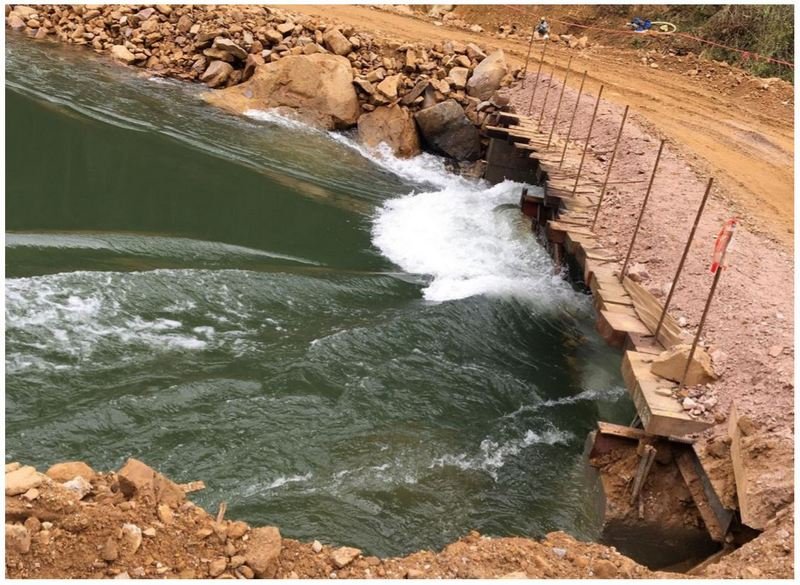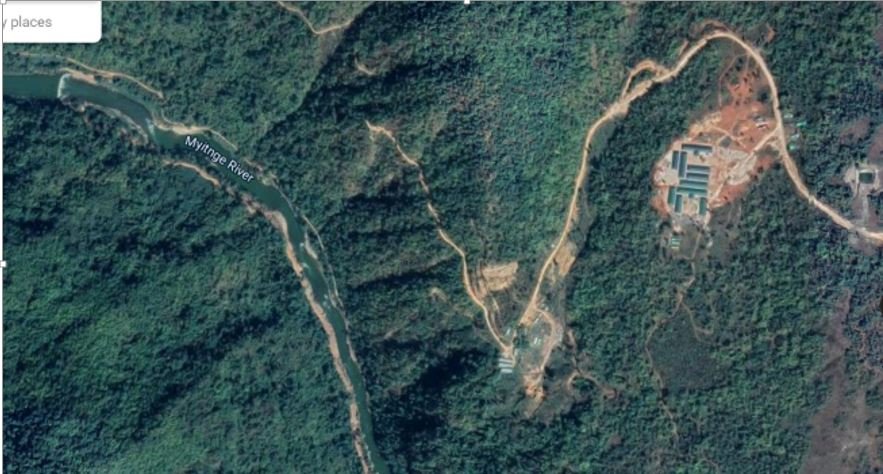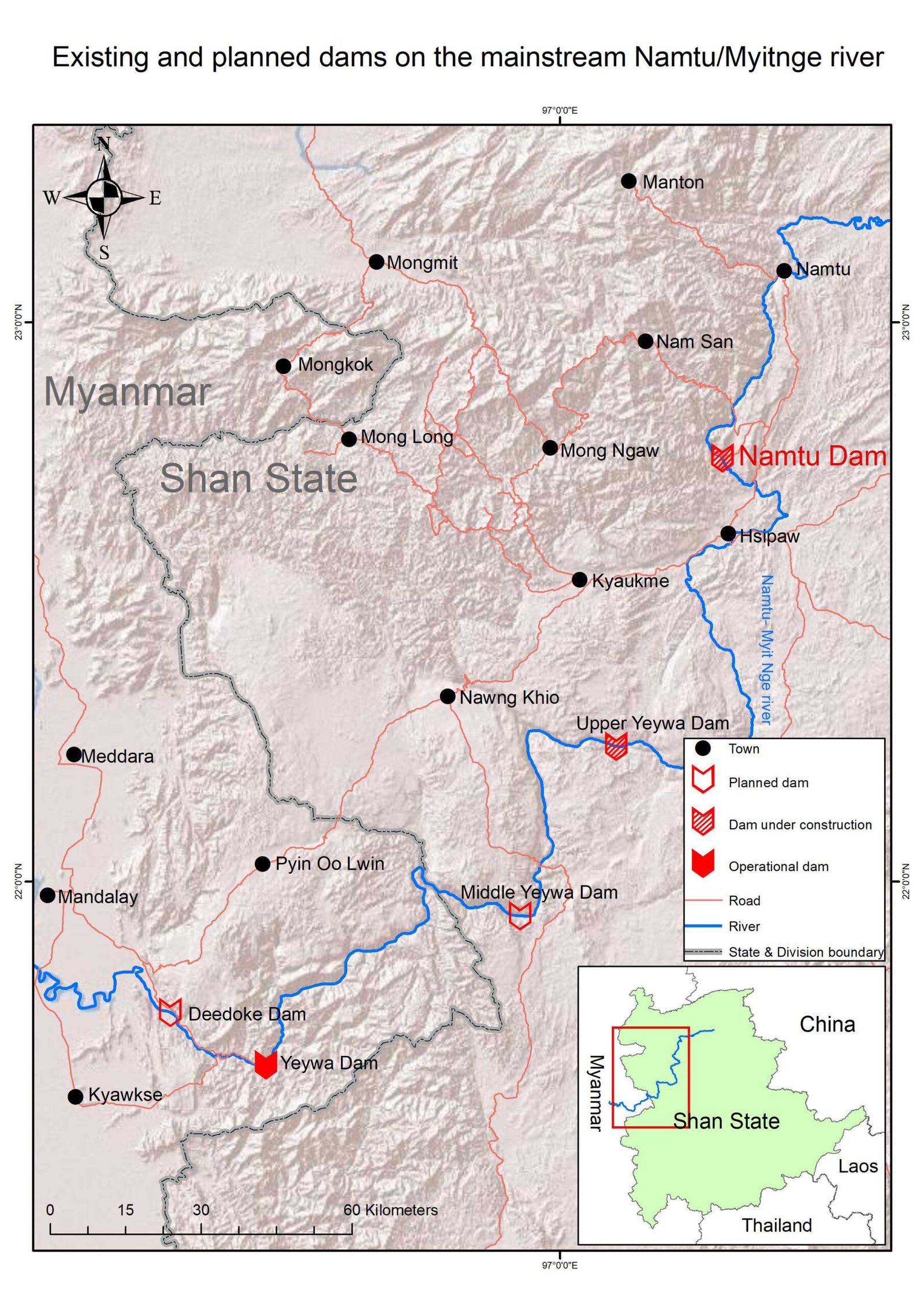Namtu/Hsipaw dam update by Action for Shan State Rivers
Unauthorized construction at Namtu/Hsipaw dam site highlights urgent need for dam moratorium in Burma
March 14, 2020
Government failure to take action over unauthorized construction at the Namtu (Hsipaw) hydropower dam site in Hsipaw, northern Shan State, highlights the urgent need for a moratorium on dam-building in Burma until devolution of power under a new federal constitution, allowing local communities to protect their own natural resources.
The Namtu dam project is being planned on the Namtu/Myitnge river, about 25 kilometers north of Hsipaw town. The project holder is Natural Current Energy Hydropower Co. Ltd. (NCEH), a Mandalay-based company registered in 2013.
NCEH has an MOU with the Burmese government for the 210 megwatt dam project, but has so far only conducted a feasibility study, which is still under review by the Ministry of Electricity and Energy (MOEE). NCEH has not yet conducted an Environmental Impact Assessment, necessary for project approval under Burma’s Environmental Conservation Law. Until the project is formally approved, NCEH is not permitted to start any construction for the project.
However, since 2017, NCEH has been clearing protected forest, building roads to the dam site, and constructing rows of concrete workers’ housing. A temporary bridge has been set up across the river, and cement reinforcement has started along the river’s edge.
Over the past two years – in February 2018 and again in December 2019 — Namtu MP Nang Kham Aye has raised formal complaints in the Naypyidaw parliament and called for the Namtu dam project to be halted, due to breach of contract. However, apart from a fine imposed on NCEH in 2017 for cutting trees without permission (only 5,000 kyat, or 3.67 USD, per tree), the MOEE has simply given warnings to the company, and no action has been taken. Meanwhile, construction is continuing on the ground, by Chinese-speaking workers. One worker was killed in a landslide on August 7, 2019.
Local communities are strongly opposed to the Namtu dam. The dam’s reservoir will stretch over 15 kilometers upstream, and will submerge the Shan village of Lilu, with 47 households and 212 people. The villagers do not want to move.
Thousands of Hsipaw villagers living downstream of the planned Namtu dam fear reduced water flow, unpredictable river level fluctuations, and blocking of fertile sediment; they also fear flooding from sudden dam releases or dam collapse.
Given plans to restart large-scale excavation in the Bawdwin-Namtu lead-silver mines, about 40 kilometers upstream of the Namtu dam site, it is also certain that the dam reservoir will become very polluted, impacting the health of villagers downstream. Lead poisoning is particularly dangerous for children, retarding physical and mental development. Australia-based Myanmar Metals, with 51% shares in the mine, plans to process two million tonnes of lead ore a year, making it the third largest producing lead mine in the world. Local communities have had no opportunity to oppose this new mining deal, awarded by the Naypyidaw government.
The Namtu dam is also located in an active war zone, where the Burma Army is continuing to launch offensives against ethnic armed resistance groups. Lilu villagers have frequently fled their homes due to fighting over the past few years. On November 26, 2019, a German tourist riding a motorcycle about seven kilometers west of the dam site was killed by a landmine.

In 2016, Shan community-based groups published a report “Save the Namtu River,”[1] calling for an immediate halt to all dam building on the Namtu river until there is a federal settlement to the civil war, giving local communities the right to decide on such projects and protect their natural resources. Unfortunately, this message has not only been ignored, but dams on the Namtu have been further promoted under the International Finance Corporation’s “sustainable hydropower development” plan for Burma[2]. Apart from the Namtu/Hsipaw dam, there are three other dams planned on the Namtu river, with investors from Austria, Norway, Switzerland, France, China and Japan.
Clearly, there is nothing “sustainable” about the dam-building taking place now on the Namtu river. The dam developers are simply exploiting the river for their own profit, without care for any social and environmental impacts or laws.
To protect our shared environment, and our communities’ health, safety and livelihoods, we call again urgently for the Burmese government to impose a moratorium on all dam-building on the Namtu – and on all other rivers in Burma – until power is devolved under a new federal constitution, and for all international investors and consultants to stop their involvement in these dams.
Basic facts about the Namtu (Hsipaw) dam (from the July 2018 EIA/SIA Scoping Report for the Namtu dam by MyAsia Consulting Co. Ltd.[3])
| Dam name | Namtu (Hsipaw) |
| Dam location | On the Namtu/Myitnge river, in Namtu township, 25 km upstream from Hsipaw town |
| Dam developer (under a Build, Operate and Transfer agreement) | Natural Current Energy Hydropower Co. Ltd. |
| Dam – Installed capacity | 210 megawatts (for Burma’s power grid) |
| Dam height | 114 meters |
| Dam crest elevation | 495 meters above sea level |
| Area to be submerged under reservoir | 866.69 hectares |
| Village to be submerged | Li Lu village (47 houses, 212 people); most inhabitants are Shan, but mistakenly called “ethnic Myanmar” in the scoping report |
| Construction period | 66 months |
| Construction cost | 436.28 million USD |
Some points of concern about the EIA/SIA Scoping Report by MyAsia Consulting Co. Ltd.:
The report selectively uses data from the IFC’s 2018 Strategic Environmental Assessment of the Hydropower Sector in Burma — giving a low ecological value rating (only 1 out of 5 for terrestrial ecology, and 2 out of 5 for aquatic ecology) for the Namtu river, and failing to mention the very high conflict vulnerability rating (5 out of 5) for the northern Shan State area where the Namtu dam is located.
The brief conflict analysis in the Scoping Report is erroneous: it states that the “Shan State Army” operating in the area has signed the Nationwide Ceasefire Agreement (NCA) and is a member of the Northern Alliance. The authors have clearly confused the Restoration Council of Shan State/Shan State Army (RCSS/SSA) — which has signed the NCA and is not a member of the Northern Alliance — with the Shan State Progress Party/Shan State Army (SSPP/SSA) — which has not signed the NCA, but is a member of the Northern Alliance.

The section of the report “Public Consultation and Disclosure” praises the NCEH for its channels of communication with the public, stating: “The project owner has kept continuous communication with the local NGOs and the local government authorities disclosing the details of the project, development plans,” next to a picture of Namtu MP Nang Kham Aye being interviewed by the consultant. This is clearly misleading, given that by the time of the publication of the scoping report in July 2018, NCEH was already ignoring concerns about their activities raised by Nang Kham Aye in parliament in February 2018.

Timeline of construction activities and legal violations by NCEH Co. Ltd.
Early 2017: NCEH Co. Ltd. began clearing forest near the dam site
Jul 18, 2017: NCEH Co. Ltd ordered to pay a fine (5,000 kyat per tree) for cutting down trees in a protected forest area in violation of Forest Law Article 40.
Feb 26, 2018: Namtu MP Nang Kham Aye raised a question in the Naypyidaw parliament to the Ministry of Electricity and Energy (MOEE), about NCEH’s continued construction in the project area despite not yet having carried out an ESIA to gain Myanmar Investment Commission (MIC) approval for the project
Mar 26, 2018: The MOEE ordered NCEH to wait for approval from MOEE before proceeding with construction. NCEH responded that it would conform to this order.
Jun 13, 2019: NCEH was permitted to dig 30,000 “kyin” (approx. 85,000 cubic meters of stones) in the Chaung Sa Protected Area, but was not permitted to build any temporary accommodation. If this was breached, the permit would be revoked. However, NCEH proceeded to build permanent housing in violation of this.
Dec 16, 2019: Namtu MP Nang Kham Aye raised a question in parliament, asking when the MIC had given approval to NCEH to implement the Namtu project.
Jan 21, 2020: The MOEE replied that the MIC had not yet given approval to NCEH for the project. NCEH had submitted a Financial Analysis for the Namtu hydropower project on June 14, 2019, and MOEE was still considering if the project was economically feasible. There were still many steps – including an environmental and social impact assessment — before the project could get MIC approval and construction could begin.
Feb 24, 2020: Namtu MP Nang Kham Aye wrote a formal complaint to the Minister of the Office of the Union Government listing the above facts, and asking that action be taken against NCEH for its repeated violations of the law.

Background information about Natural Current Energy Hydropower Co. Ltd. (NCEH)
NCEH Co Ltd was registered with the Directorate of Investment and Company Administration (DICA) on November 7, 2013. According to its website[4], its head office is in Mandalay, with a branch office in Naypyidaw. NCEH Director U Kyaw Sein is also Director of Shwe Oak Khai Construction Co. Ltd.
NCEH’s website states that “over the years, the company has undertaken many challenging projects,” but does not list any. The website Gallery shows photos of what appears to be the Namtu river project, but there are no captions.
Sources in Lashio say that NCEH is also developing four smaller hydropower dams (15 MW, 18 MW, 20 MW and 22 MW) on the Nam Nim river, a Salween tributary which flows through Kutkai and Hsenwi before joining the Salween near Kunlong.
Press release PDF files: >> Shan| Burmese| English
Namtu/Hipaw dam PDF files: >> Shan| Burmese| English
[1] https://shanhumanrights.org/wp-content/uploads/2021/03/03-30-2016-Namtu-English-1.pdf
[3] http://www.myasiaconsulting.com/pdf/Hsipaw_Scoping_Report.pdf
[4] https://ncehydropower.com/index.php
Contact:
Sai Thum Ai (One of the organizers) +95 (0)9-453-132-755
Nang Lao Kham (Ta Long villager) +95 (0)9-262-108-062




